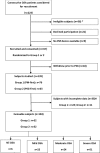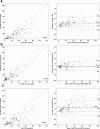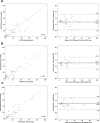A Comprehensive Evaluation of a Two-Channel Portable Monitor to "Rule in" Obstructive Sleep Apnea
- PMID: 25580606
- PMCID: PMC4365457
- DOI: 10.5664/jcsm.4600
A Comprehensive Evaluation of a Two-Channel Portable Monitor to "Rule in" Obstructive Sleep Apnea
Abstract
Study objectives: We hypothesized that a dual-channel portable monitor (PM) device could accurately identify patients who have a high pretest probability of obstructive sleep apnea (OSA), and we evaluated factors that may contribute to variability between PM and polysomnography (PSG) results.
Methods: Consecutive clinic patients (N = 104) with possible OSA completed a home PM study, a PM study simultaneous with laboratory PSG, and a second home PM study. Uniform data analysis methods were applied to both PM and PSG data. Primary outcomes of interest were the positive likelihood ratio (LR+) and sensitivity of the PM device to "rule-in" OSA, defined as an apnea-hypopnea index (AHI) ≥ 5 events/h on PSG. Effects of different test environment and study nights, and order of study and analysis methods (manual compared to automated) on PM diagnostic accuracy were assessed.
Results: The PM has adequate LR+ (4.8), sensitivity (80%), and specificity (83%) for detecting OSA in the unattended home setting when benchmarked against laboratory PSG, with better LR+ (> 5) and specificity (100%) and unchanged sensitivity (80%) in the simultaneous laboratory comparison. There were no significant night-night (all p > 0.10) or study order effects (home or laboratory first, p = 0.08) on AHI measures. Manual PM data review improved case finding accuracy, although this was not statistically significant (all p > 0.07). Misclassification was more frequent where OSA was mild.
Conclusions: Overall performance of the PM device is consistent with current recommended criteria for an "acceptable" device to confidently "rule-in" OSA (AHI ≥ 5 events/h) in a high pretest probability clinic population. Our data support the utility of simple two-channel diagnostic devices to confirm the diagnosis of OSA in the home environment.
Commentary: A commentary on this article appears in this issue on page 411.
Keywords: obstructive sleep apnea; portable monitor; positive likelihood ratio; rule-in; sensitivity; type 4; validation.
© 2015 American Academy of Sleep Medicine.
Figures



Comment in
-
Home Sleep Testing: It's Not How You Play the Game, It's Whether You Win or Lose.J Clin Sleep Med. 2015 Apr 15;11(4):411-2. doi: 10.5664/jcsm.4592. J Clin Sleep Med. 2015. PMID: 25766703 Free PMC article. No abstract available.
References
-
- Flemons WW. Clinical practice. Obstructive sleep apnea. N Engl J Med. 2002;347:498–504. - PubMed
-
- Jennum P, Riha RL. Epidemiology of sleep apnoea/hypopnoea syndrome and sleep-disordered breathing. Eur Respir J. 2009;33:907–14. - PubMed
-
- Pack AI. Sleep-disordered breathing: access is the issue. Am J Respir Crit Care Med. 2004;169:666–7. - PubMed
-
- Somers VK, White DP, Amin R, et al. Sleep apnea and cardiovascular disease: an American Heart Association/American College of Cardiology Foundation Scientific Statement from the American Heart Association Council for High Blood Pressure Research Professional Education Committee, Council on Clinical Cardiology, Stroke Council, and Council on Cardiovascular Nursing. J Am Coll Cardiol. 2008;52:686–717. - PubMed
Publication types
MeSH terms
LinkOut - more resources
Full Text Sources
Other Literature Sources

